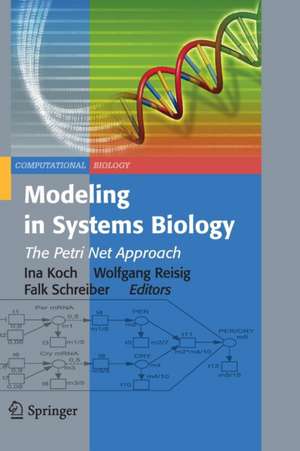Modeling in Systems Biology: The Petri Net Approach: Computational Biology, cartea 16
Editat de Ina Koch, Wolfgang Reisig, Falk Schreiberen Limba Engleză Paperback – 3 dec 2012
| Toate formatele și edițiile | Preț | Express |
|---|---|---|
| Paperback (1) | 644.95 lei 6-8 săpt. | |
| SPRINGER LONDON – 3 dec 2012 | 644.95 lei 6-8 săpt. | |
| Hardback (1) | 649.87 lei 6-8 săpt. | |
| SPRINGER LONDON – 23 oct 2010 | 649.87 lei 6-8 săpt. |
Din seria Computational Biology
- 20%
 Preț: 539.14 lei
Preț: 539.14 lei - 15%
 Preț: 645.60 lei
Preț: 645.60 lei - 15%
 Preț: 633.68 lei
Preț: 633.68 lei - 20%
 Preț: 637.06 lei
Preț: 637.06 lei - 5%
 Preț: 1434.18 lei
Preț: 1434.18 lei - 18%
 Preț: 945.79 lei
Preț: 945.79 lei -
 Preț: 322.31 lei
Preț: 322.31 lei - 18%
 Preț: 945.13 lei
Preț: 945.13 lei -
 Preț: 447.56 lei
Preț: 447.56 lei - 15%
 Preț: 643.65 lei
Preț: 643.65 lei - 15%
 Preț: 648.89 lei
Preț: 648.89 lei - 18%
 Preț: 900.80 lei
Preț: 900.80 lei - 15%
 Preț: 653.14 lei
Preț: 653.14 lei -
 Preț: 400.85 lei
Preț: 400.85 lei - 15%
 Preț: 696.50 lei
Preț: 696.50 lei -
 Preț: 387.96 lei
Preț: 387.96 lei - 15%
 Preț: 645.79 lei
Preț: 645.79 lei - 20%
 Preț: 560.67 lei
Preț: 560.67 lei - 15%
 Preț: 653.65 lei
Preț: 653.65 lei - 15%
 Preț: 638.57 lei
Preț: 638.57 lei - 20%
 Preț: 575.99 lei
Preț: 575.99 lei - 18%
 Preț: 1112.15 lei
Preț: 1112.15 lei - 18%
 Preț: 785.42 lei
Preț: 785.42 lei - 20%
 Preț: 1047.22 lei
Preț: 1047.22 lei - 18%
 Preț: 1230.84 lei
Preț: 1230.84 lei
Preț: 644.95 lei
Preț vechi: 758.77 lei
-15% Nou
Puncte Express: 967
Preț estimativ în valută:
123.41€ • 129.11$ • 102.52£
123.41€ • 129.11$ • 102.52£
Carte tipărită la comandă
Livrare economică 02-16 aprilie
Preluare comenzi: 021 569.72.76
Specificații
ISBN-13: 9781447125983
ISBN-10: 1447125983
Pagini: 388
Ilustrații: XXIV, 364 p.
Dimensiuni: 155 x 235 x 20 mm
Greutate: 0.54 kg
Ediția:2011
Editura: SPRINGER LONDON
Colecția Springer
Seria Computational Biology
Locul publicării:London, United Kingdom
ISBN-10: 1447125983
Pagini: 388
Ilustrații: XXIV, 364 p.
Dimensiuni: 155 x 235 x 20 mm
Greutate: 0.54 kg
Ediția:2011
Editura: SPRINGER LONDON
Colecția Springer
Seria Computational Biology
Locul publicării:London, United Kingdom
Public țintă
ResearchCuprins
Part I: Foundations.- Introduction.- Biochemical Fundamentals.- Petri Nets.- Part II: Modeling Techniques.- Discrete Modeling.- Modeling Genetic Regulatory Networks.- Hybrid Functional Petri Net with Extension for Dynamic Pathway Modeling .- Stochastic Modeling.- Quantitative Analysis.- Fuzzy Modeling.- Part III: Biochemical Applications.- Topological Analysis of Metabolic and Regulatory Networks.- Analysis of Dynamical Models of Signaling Networks with Petri Nets and Dynamic Graphs.- A Modular, Qualitative Modeling of Regulatory Networks Using Petri Nets.- A Case Study of HFPN Simulation: Finding Essential Roles of Ror Gene in the Interaction of Feedback Loops in Mammalian Circadian Clock.- Prediction of Network Structure.
Recenzii
From the reviews:
“This volume brings together a variety of contributions showcasing the application of modeling biological and biochemical processes using Petri nets. … it can be used as a teaching aid, and have included exercises at the end of each chapter. … the volume is best seen as a roadmap to a variety of interesting uses of a modeling technique that is particularly geared to readers who already have some experience with mathematical modeling in biology.” (Sara Kalvala, ACM Computing Reviews, August, 2011)
“This volume brings together a variety of contributions showcasing the application of modeling biological and biochemical processes using Petri nets. … it can be used as a teaching aid, and have included exercises at the end of each chapter. … the volume is best seen as a roadmap to a variety of interesting uses of a modeling technique that is particularly geared to readers who already have some experience with mathematical modeling in biology.” (Sara Kalvala, ACM Computing Reviews, August, 2011)
Textul de pe ultima copertă
The emerging, multi-disciplinary field of systems biology is devoted to the study of the relationships between various parts of a biological system, and computer modeling plays a vital role in the drive to understand the processes of life from an holistic viewpoint. Advancements in experimental technologies in biology and medicine have generated an enormous amount of biological data on the dependencies and interactions of many different molecular cell processes, fueling the development of numerous computational methods for exploring this data. The mathematical formalism of Petri net theory is able to encompass many of these techniques.
This essential text/reference presents a comprehensive overview of cutting-edge research in applications of Petri nets in systems biology, with contributions from an international selection of experts. Those unfamiliar with the field are also provided with a general introduction to systems biology, the foundations of biochemistry, and the basics of Petri net theory. Further chapters address Petri net modeling techniques for building and analyzing biological models, as well as network prediction approaches, before reviewing the applications to networks of different biological classification.
Topics and features:
Dr. Ina Koch is a Professor and holds the Chair of Bioinformatics at the Johann Wolfgang Goethe-University Frankfurt am Main, Germany.
Dr. Wolfgang Reisig is a Professor and holds the Chair in the Theory of Programming at the Humboldt University of Berlin, Germany.
Dr. Falk Schreiber is a Professor and holds the Chair of Bioinformatics at the Martin Luther University Halle-Wittenberg, Germany, and the Coordinator of Bioinformatics at the Leibniz Institute of Plant Genetics and Crop Plant Research Gatersleben, Germany.
This essential text/reference presents a comprehensive overview of cutting-edge research in applications of Petri nets in systems biology, with contributions from an international selection of experts. Those unfamiliar with the field are also provided with a general introduction to systems biology, the foundations of biochemistry, and the basics of Petri net theory. Further chapters address Petri net modeling techniques for building and analyzing biological models, as well as network prediction approaches, before reviewing the applications to networks of different biological classification.
Topics and features:
- Investigates the modular, qualitative modeling of regulatory networks using Petri nets, and examines an Hybrid Functional Petri net simulation case study
- Contains a glossary of the concepts and notation used in the book, in addition to exercises at the end of each chapter
- Covers the topological analysis of metabolic and regulatory networks, the analysis of models of signaling networks, and the prediction of network structure
- Provides a biological case study on the conversion of logical networks into Petri nets
- Discusses discrete modeling, stochastic modeling, fuzzy modeling, dynamic pathway modeling, genetic regulatory networkmodeling, and quantitative analysis techniques
- Includes a Foreword by Professor Jens Reich, Professor of Bioinformatics at Humboldt University and Max Delbrück Center for Molecular Medicine in Berlin
Dr. Ina Koch is a Professor and holds the Chair of Bioinformatics at the Johann Wolfgang Goethe-University Frankfurt am Main, Germany.
Dr. Wolfgang Reisig is a Professor and holds the Chair in the Theory of Programming at the Humboldt University of Berlin, Germany.
Dr. Falk Schreiber is a Professor and holds the Chair of Bioinformatics at the Martin Luther University Halle-Wittenberg, Germany, and the Coordinator of Bioinformatics at the Leibniz Institute of Plant Genetics and Crop Plant Research Gatersleben, Germany.
Caracteristici
Presents a comprehensive overview of cutting-edge research in applications of Petri nets in systems biology Enables readers to apply and develop their own biochemical models using Petri net techniques Contains a glossary of the concepts and notation used in the book, in addition to exercises at the end of each chapter Includes supplementary material: sn.pub/extras

















